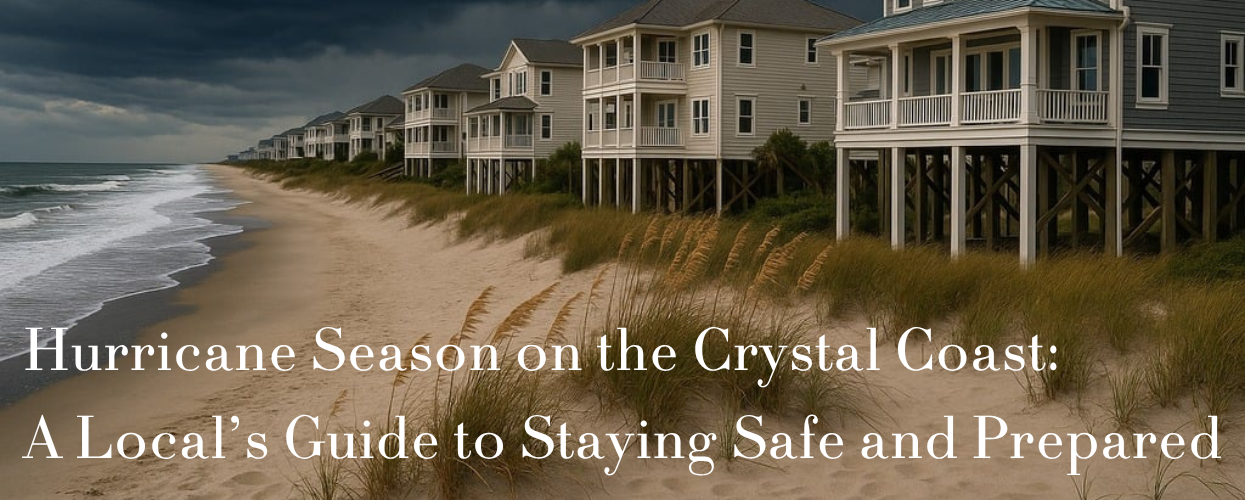
By Lugean Hogan, Broker/Realtor, Certified Luxury Home Marketing Specialist
Living on the Crystal Coast is a blessing. The beauty of our shoreline, the charm of our small towns, and the strength of our community are unmatched. But life near the Atlantic also means being prepared for one of nature's most powerful forces: hurricanes.
Having lived in Carteret County for over 40 years, I’ve weathered my fair share of storms. Each one is a reminder that preparation is not just important—it’s essential. As a long-time resident, a real estate professional, and someone who genuinely cares about this community, I want to share what I tell my neighbors yearly before hurricane season begins.
This guide is designed to help you prepare your home, your loved ones, and yourself with confidence. Whether it’s your first season here or your fiftieth, these steps are worth revisiting.
1. Start with a Family Plan
A solid plan is the foundation of hurricane preparedness. Knowing where to go and what to do in case of an evacuation can reduce panic and confusion.
Create a communication plan with your household. Decide where you'll meet if separated and how you’ll stay in touch. Designate an out-of-town contact everyone can check in with.
Map out evacuation routes now—don’t wait until the storm is close. Keep a paper map handy in case GPS services go down. Identify shelters nearby and check whether they accommodate pets.
Did you know that Carteret County has established predetermined evacuation zones to simplify the process? You can now use the "Know Your Zone" interactive map to determine your zone by address. Evacuation routes are well-marked with blue and white signs, including U.S. 70, NC Highway 101, and NC Highway 58 (carteretcountync.gov).
Tip: Keep a list of emergency contacts posted somewhere visible in your home, like the refrigerator.
2. Build a Comprehensive Emergency Kit
When a hurricane is approaching, supplies tend to vanish from store shelves quickly. Stock your emergency kit early in the season. The Federal Emergency Management Agency (FEMA) recommends having enough supplies to last each person at least 72 hours.
Emergency Supply Kit Table
| Category | Items to Include |
| Essentials | Water (1 gal/person/day), non-perishable food, can opener |
| Power & Light | Flashlights, batteries, power banks, hand-crank radio |
| Health & Safety | First aid kit, masks, sanitizer, medications |
| Documents | Insurance, IDs, medical records in waterproof pouch |
| Comfort Items | Blankets, personal hygiene items, pet food |
Tip: Refresh your kit each year by checking expiration dates and replacing used or outdated items.
3. Secure Important Documents
In the aftermath of a hurricane, access to vital documents can make a world of difference when filing insurance claims or seeking assistance.
Place the following in a waterproof folder or fireproof safe:
- Homeowners or renters insurance
- Vehicle registration and insurance
- Medical records and prescriptions
- Passports and birth certificates
- Social Security cards
- Mortgage and property records
Tip: Take photos of the contents of your home. This can greatly support insurance claims if needed.
4. Prepare Your Home
Your home is more than a structure—it's your sanctuary. Taking time to prepare it can help prevent costly damage.
Start by inspecting your roof, windows, doors, and garage doors. Install storm shutters or pre-cut plywood to cover windows. Ensure your gutters and downspouts are clear to allow for proper drainage.
Bring inside anything that could become a projectile in high winds. This includes patio furniture, grills, potted plants, and garden tools.
Trim trees and shrubs around your property. Weak branches can easily break and cause damage.
Turn your refrigerator and freezer to their coldest settings. If power is lost, this helps keep food safe for longer.
Pros/Cons Table: Window Protection Options
| Option | Pros | Cons |
| Storm Shutters | Reusable, durable | Higher upfront cost |
| Plywood Panels | Affordable, widely available | Labor-intensive, less aesthetic |
In 2018, Hurricane Florence hit Carteret County hard, with winds exceeding 100 mph, a storm surge of up to 7 feet, and over 30 inches of rain in some areas. Thousands of homes sustained severe damage (National Weather Service).
Tip: Consider investing in a portable generator. Use it safely and only in well-ventilated areas.
5. Understand When and How to Shut Off Utilities
In certain situations, turning off your utilities may prevent further damage or danger. Know in advance how to shut off your electricity, gas, and water lines.
If you evacuate, it may be recommended to turn off these services. Doing so can reduce the risk of electrical fires or water damage should pipes burst.
Tip: Label your shutoff valves and switches for quick identification.
6. Monitor Weather Updates and Follow Local Guidance
Reliable information is critical during a hurricane. Tune in to trusted sources like the National Hurricane Center, NOAA Weather Radio, or local news outlets.
As Rick Knabb, former director of the National Hurricane Center, says: “Now is the time to prepare—before a storm is on your doorstep” (app.com).
Tip: Avoid relying on social media for critical updates unless the source is verified and official.
7. Recovery: What to Do After the Storm
Even after the wind dies down and the skies clear, danger may still be present. Wait for authorities to declare your area safe before returning home.
Check for structural damage cautiously. Avoid downed power lines and standing water, which may conceal hazards or electrical current.
| Contractor Type | Pros | Cons |
| Local | Known reputation, community accountability | May have longer wait times |
| Out-of-Town | More availability | Risk of scams, less oversight |
In September 2024, Tropical Cyclone 8 caused severe beach erosion along the Bogue Banks, stripping away up to 239,000 cubic yards of sand and leaving many communities scrambling to repair their shorelines (witn.com).
Tip: Use caution when hiring contractors for repairs. Work with licensed professionals and avoid scams.
A Personal Note on Preparedness
I remember one year when a hurricane approached faster than expected. My phone didn’t stop ringing—friends, clients, neighbors—everyone wanted to know what to do.
That’s the thing about living here. We take care of each other. Preparation isn’t just about safeguarding property. It’s about protecting people. And while every storm is different, the steps to stay safe remain the same.
As a 2023 report from the Earthquake Engineering Research Institute put it best: “The impact of the next hurricane is being decided right now—in the days, weeks, and months of preparation that are required to make communities resistant to disaster” (EERI Report).
I hope this guide serves as a reminder to take the time now—before the wind kicks up—to get ready.
Frequently Asked Questions (FAQs)
What should I include in a hurricane emergency kit?
You should include water, non-perishable food, flashlights, batteries, first-aid supplies, important documents, hygiene items, and phone chargers—enough to last each person at least 72 hours.
How can I find out if I'm in an evacuation zone in Carteret County?
You can use the “Know Your Zone” interactive map to check your evacuation zone based on your address.
What should I do after a hurricane passes?
Wait for authorities to declare your area safe, check your property for damage, avoid downed power lines and floodwaters, and document everything for insurance purposes.
Final Thoughts: Let’s Weather This Together
At Star Team Real Estate, we’re not just here to help you buy or sell a home. We’re your neighbors, your friends, and your advocates. We understand what it means to live on the Crystal Coast because we live here too.
We’re committed to helping our community prepare, stay safe, and recover—every hurricane season and every day in between.
If you ever have questions, whether it’s about home safety, flood zones, or local resources, don’t hesitate to reach out. Our team is always here to help.
Stay safe, stay prepared, and remember—you’re not alone.


